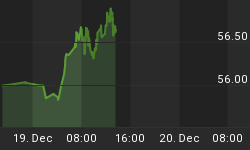It was an interesting week. Considerable volatility in the foreign exchange markets (the dollar fell 5.5 handles from 105.50 yen to 95 yen before bouncing to 97.5 yen at week's end) and a slide in several foreign equity markets (chiefly the Nikkei, -6.5%, but also the UK -2.6%, Italy -3.0%, Mexico, Brazil, Turkey -9%, etc) impacted the U.S. bourse at the margin but not severely. On Monday, a weak ISM helped push US stocks lower and bonds higher; but on Friday an as-expected Employment report led to a massive equity rally and sharp losses on bonds with the 10-year yield reaching a new high for the move.
The reaction from bonds isn't terribly surprising. Bond funds are seeing near-record outflows as everyone knows that yields would not be near these levels without Fed backing, and no one wants to be the last one out. Any fear that "taper" is going to happen soon was going to send yields higher, and as I wrote on May 29th there is some risk for much higher yields.
The equity reaction on Friday is a little more confusing. Sure, the airwaves were full of news of the "better than expected" payrolls, although the combination of the May positive surprise (+12k) and the revisions to the prior two months (-12k) puts the Jobs number precisely on the consensus estimates while the Unemployment Rate rise slightly due to a rise in the participation rate. To be sure, there is nothing in the number to force the Fed to consider a "taper" with any kind of urgency, but considering that Bernanke and Dudley have already signaled that no taper is imminent, this is hardly news: the data on Friday was almost exactly as-expected.
Going forward, the market continues to face the same hurdles: higher rates mean more competition for investment dollars and will pressure equity prices. Lower unemployment implies that the current ratio of real wage growth relative to gross margins - which reflects the great power of capital right now relative to labor, with margins at record highs while real wages stagnate - will begin to shift back in favor of wages and away from capital. Higher rates also imply higher money velocity and hence, higher inflation. (See chart, source Bloomberg.)

If 5-year rates went to, say, 2%, and M2 velocity rose to 1.732 as the regression suggests, it would represent a 12.9% rise in money velocity. If M2 merely ticks along at the current (high, but not as high as it was) rate of 6.6% growth year-on-year, and GDP grows at an optimistic 4% rate, then it implies inflation of roughly 15.7% (1.129 * 1.066 / 1.04).
There are a lot of "ifs" in that statement, and I want to make clear that I am not forecasting 15.7% inflation over the next year, or even the next two years combined. But the point is that the risks are not insignificant. It isn't a rise of core CPI to 2.5% by year-end that is the potential problem, although stocks might not take that well. It is a rise above that, which causes rates to rise, which causes velocity to accelerate further, etcetera in a spiral that the Fed is powerless to do anything about since it must first remove $1.9 trillion in excess reserves from the banking system...
And in that sort of inflationary environment, equities would be roundly trashed. A reader asked me to expound further on my prior observations about equities and inflation, and this seems like the right place to do it. However, so as to limit the length of this article, I am posting that further discussion/article separately here.
You can follow me @inflation_guy!
Enduring Investments is a registered investment adviser that specializes in solving inflation-related problems. Fill out the contact form at http://www.EnduringInvestments.com/contact and we will send you our latest Quarterly Inflation Outlook. And if you make sure to put your physical mailing address in the "comment" section of the contact form, we will also send you a copy of Michael Ashton's book "Maestro, My Ass!"















